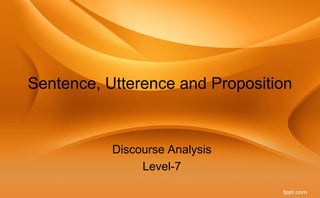Sentence, Utterence and Proposition
•Download as PPT, PDF•
1 like•560 views
Linguistics
Report
Share
Report
Share

Recommended
More Related Content
What's hot
What's hot (20)
Two Views of Discourse Structure: As a Product and As a Process

Two Views of Discourse Structure: As a Product and As a Process
Similar to Sentence, Utterence and Proposition
Similar to Sentence, Utterence and Proposition (20)
Discourse Analysis presentation by Ali Asghar 011.ppt

Discourse Analysis presentation by Ali Asghar 011.ppt
2 Basic Concepts and TerminologyI have to admit, sometimes I ge.docx

2 Basic Concepts and TerminologyI have to admit, sometimes I ge.docx
More from Dr. Mohsin Khan
More from Dr. Mohsin Khan (20)
Recently uploaded
https://app.box.com/s/x7vf0j7xaxl2hlczxm3ny497y4yto33i80 ĐỀ THI THỬ TUYỂN SINH TIẾNG ANH VÀO 10 SỞ GD – ĐT THÀNH PHỐ HỒ CHÍ MINH NĂ...

80 ĐỀ THI THỬ TUYỂN SINH TIẾNG ANH VÀO 10 SỞ GD – ĐT THÀNH PHỐ HỒ CHÍ MINH NĂ...Nguyen Thanh Tu Collection
Recently uploaded (20)
80 ĐỀ THI THỬ TUYỂN SINH TIẾNG ANH VÀO 10 SỞ GD – ĐT THÀNH PHỐ HỒ CHÍ MINH NĂ...

80 ĐỀ THI THỬ TUYỂN SINH TIẾNG ANH VÀO 10 SỞ GD – ĐT THÀNH PHỐ HỒ CHÍ MINH NĂ...
Exploring_the_Narrative_Style_of_Amitav_Ghoshs_Gun_Island.pptx

Exploring_the_Narrative_Style_of_Amitav_Ghoshs_Gun_Island.pptx
21st_Century_Skills_Framework_Final_Presentation_2.pptx

21st_Century_Skills_Framework_Final_Presentation_2.pptx
Sensory_Experience_and_Emotional_Resonance_in_Gabriel_Okaras_The_Piano_and_Th...

Sensory_Experience_and_Emotional_Resonance_in_Gabriel_Okaras_The_Piano_and_Th...
dusjagr & nano talk on open tools for agriculture research and learning

dusjagr & nano talk on open tools for agriculture research and learning
NO1 Top Black Magic Specialist In Lahore Black magic In Pakistan Kala Ilam Ex...

NO1 Top Black Magic Specialist In Lahore Black magic In Pakistan Kala Ilam Ex...
Play hard learn harder: The Serious Business of Play

Play hard learn harder: The Serious Business of Play
Unit 3 Emotional Intelligence and Spiritual Intelligence.pdf

Unit 3 Emotional Intelligence and Spiritual Intelligence.pdf
HMCS Vancouver Pre-Deployment Brief - May 2024 (Web Version).pptx

HMCS Vancouver Pre-Deployment Brief - May 2024 (Web Version).pptx
Sentence, Utterence and Proposition
- 1. Sentence, Utterence and Proposition Discourse Analysis Level-7
- 2. Introduction • Between the terms sentence and utterance, one can identify some difference when studying linguistics. First let us gain a basic understanding of what each term mean. • A sentence is a group of words that convey a meaning. • An utterance is also a group of words or a part of speech in between pauses. • A sentence can be in both written and spoken language. But an utterance is usually confined to the spoken language. • A proposition is an abstraction that can be grasped by the mind of an individual person; in that sense, a proposition is an object of thought.
- 3. Sentence • A sentence is a group of words that conveys a complete meaning or thought which is grammatically complete string of words. • A sentence at least contains a subject and verb that highlights that a sentence conveys a complete meaning because it is a combination of words which are syntactic in nature. • For example, when we say ‘she left,’ even though it has just the subject and verb it conveys a meaning. However, sentences are not always simple in structure. • There are a number of categories in sentences such as simple sentences, compound sentences, complex sentences, and also compound-complex sentences.
- 4. Utterence • Utterance can be defined as a part of speech between pauses and silence. This usually applies to spoken language and not for written language. This feature can be considered as a difference that exists between a sentence and an utterance. • An utterance can be a single word, a group of words, a clause or even a complete sentence. • In oral/spoken language utterances have several features including paralinguistic features which are aspects of speech such as facial expression, gesture, and posture. Prosodic features include stress, intonation, and tone of voice, as well as ellipsis, which are words that the listener inserts in spoken language to fill gaps.
- 5. Difference between Sentence and Utterance • A sentence is a group of words that conveys a meaning. • An utterance is also a group of words or a part of speech in between pauses. • Both a sentence and utterance convey a meaning to the reader or listener. • The difference between a sentence and utterance is that while a sentence conveys a complete meaning through a combination of clauses, an utterance conveys a meaning through a few words that may not even compile a clause. • A sentence is in both written and spoken language, but an utterance is in spoken language only.
- 6. Proposition Proposition is an abstraction that can be grasped by the mind of an individual person; in that sense, a proposition is an object of thought. It is an element of interpretation or we can say a unit of logical analysis. Proposition primarily belongs to the semantics which involves inference. For example; John’s son James is an academician. Propositions; 1- John is a married man. 2- john is the father of James. 3- James is an educated person. 4- James belongs to academic profession. Etc.
